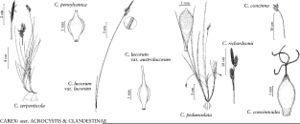Carex pedunculata
Sp. Pl. 4(1): 222. 1805.
Plants cespitose, stout-rhizomatous. Culms 8.8–28 cm. Leaves: basal sheaths dark reddish to purplish brown; blades mostly basal, dark green, equaling or mostly exceeding culms, 1.4–4 mm wide, thick, margins smooth or scabrous. Inflorescences: peduncles of basal pistillate spikes filiform, arching, to 13 cm; peduncles of terminal staminate spikes 2–6 cm; proximal bracts short-sheathing; pistillate spikes 2–5, mostly emerging from basal nodes, proximal spikes arching, distal ones ascending, short-pedunclulate, widely separated, often with 1–2 staminate flowers at apex, obovoid to ellipsoid; terminal staminate spikes usually with 2–5 pistillate flowers at base, 7.5–9.8 × 1.8–2.3 mm. Scales: pistillate scales pale brown to reddish brown, ovate to obovate, apex retuse or truncate to obtuse, cuspidate; staminate scales dark reddish brown, ovate, apex cuspidate. Anthers 2–3.6 mm. Perigynia obovoid to oblanceoloid, 3.7–6 × 1.4–1.7 mm, base tapering, pubescent with short straight hairs; beak bent, 0.2–0.4 mm. Stigmas 3, thin, flexuous, strongly papillose. Achenes ellipsoid, 2.5 × 1.5–1.6 mm. 2n = 26.
Phenology: Fruiting spring–summer (mid Apr–early Jul).
Habitat: Moist to dry mixed forests and woodland openings, on basic and acidic substrates
Elevation: 0–800 m
Distribution

St. Pierre and Miquelon, Alta., B.C., Man., N.B., Nfld. and Labr., N.S., Ont., Que., Sask., Ala., Conn., Del., Ga., Ill., Ind., Iowa, Ky., Maine, Md., Mass., Mich., Minn., N.H., N.J., N.Y., N.C., Ohio, Pa., R.I., S.Dak., Tenn., Vt., Va., W.Va., Wis., e Asia.
Discussion
Carex pedunculata is one of the early-flowering woodland sedges. Its achenes are subtended by elaiosomes, which facilitate dispersal by serving as attractants and food sources for ants (S. Handel 1976). This species has been characterized as a “fugitive species,” colonizing openings in woodlands, and decreasing in abundance as other woodland species begin to compete with it.
Carex pedunculata exhibits the classical eastern North Americaneastern Asian disjunct distribution pattern (P. W. Ball 1990). The Korean counterpart is known as var. erythrobasis (H. Léveillé & Vaniot) T. Koyama.
